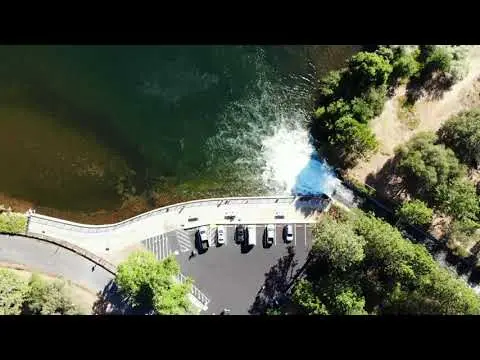Halsey Forebay is an intriguing water body that has garnered interest among locals, visitors, and environmental enthusiasts alike. Situated in the scenic Sierra Nevada foothills of California, this small reservoir plays an essential role in the region’s water management system. But how deep is Halsey Forebay? This question isn’t just about numbers; it touches on aspects of hydrology, environmental significance, and recreational use. In this article, we’ll dive into the depth of Halsey Forebay, exploring its physical dimensions, ecological impact, and much more.
Understanding Halsey Forebay: An Overview
Location and Purpose
Halsey Forebay is located near the town of Colfax in Placer County, California. It forms part of the Drum-Spaulding Hydroelectric Project, operated by Pacific Gas and Electric Company (PG&E). The forebay is a small reservoir or pond created by damming the flow of water from the Bear River. It acts as a regulating basin, helping to manage water flow between the upstream storage reservoirs and downstream powerhouses.
Importance in Water Management
The primary function of Halsey Forebay is to regulate water for hydroelectric power generation. It temporarily stores water before it’s released into penstocks (large pipes) that convey it to turbines. This system ensures a steady water supply for generating electricity, even during periods of fluctuating water levels in the river.
Halsey Forebay also plays a role in flood control, irrigation, and providing a habitat for local wildlife. Its management is crucial for maintaining the ecological balance and ensuring the continued availability of water resources in the region.

The Depth of Halsey Forebay
Official Depth Measurements
Halsey Forebay is relatively shallow compared to large reservoirs. According to official records, the maximum depth of Halsey Forebay is approximately 45 feet (13.7 meters). The depth, however, can vary depending on factors such as water inflow, seasonal changes, and operational requirements.
Factors Affecting Depth
Several factors influence the depth of Halsey Forebay:
- Seasonal Variations: During the rainy season, the forebay can reach its maximum depth, while in the dry season, water levels may drop significantly.
- Water Management Operations: As part of a hydroelectric system, water levels are manipulated according to the needs of power generation, irrigation, and flood control.
- Sedimentation: Over time, sediment can accumulate at the bottom of the forebay, gradually reducing its depth. Regular dredging may be required to maintain its capacity.
Comparison with Other Reservoirs
When compared to larger reservoirs like Shasta Lake or Lake Oroville, which have depths exceeding 400 feet, Halsey Forebay is quite shallow. However, its depth is adequate for its intended purpose of regulating water flow and supporting the hydroelectric system.
Ecological and Environmental Significance
Aquatic Life
Despite its relatively shallow depth, Halsey Forebay supports a variety of aquatic life. Fish species such as trout, bass, and catfish are commonly found in the forebay, making it a popular spot for recreational fishing. The depth provides a suitable environment for these species, particularly during the cooler months when water temperatures are lower.
You may like The Ultimate Guide to Golfklúbbar
Bird Habitat
The forebay and its surrounding areas are also a haven for birdlife. Species like herons, egrets, and ducks can often be seen feeding in the shallow waters. The combination of open water and surrounding vegetation creates an ideal habitat for these birds.
Impact of Water Depth on Ecology
The depth of Halsey Forebay plays a crucial role in determining the types of species that can thrive there. Shallow waters tend to warm up more quickly, which can influence the types of plants and animals that inhabit the forebay. In deeper areas, cooler temperatures prevail, providing a refuge for species that prefer such conditions.
Recreational Use and Safety Considerations
Fishing and Boating
Halsey Forebay is a popular spot for recreational activities such as fishing, kayaking, and canoeing. The shallow depth makes it particularly suitable for these activities, as it allows for easy access and safer conditions compared to deeper lakes.

Safety Tips for Visitors
While Halsey Forebay is generally safe for recreational use, it’s essential to be aware of a few safety considerations:
- Water Depth Awareness: Be mindful that water levels can change, and areas that were shallow one day could be deeper the next.
- Cold Water Caution: Even in shallow waters, temperatures can be cold, especially in deeper sections of the forebay. Always wear appropriate gear when engaging in water activities.
- Wildlife Awareness: Be respectful of the local wildlife, particularly during nesting or spawning seasons. Avoid disturbing animals and their habitats.
Accessibility and Facilities
Halsey Forebay is accessible to the public, with designated areas for fishing and picnicking. However, it’s a relatively remote location, so visitors should come prepared with necessary supplies and ensure they follow Leave No Trace principles to protect the environment.
The Role of Depth in Hydroelectric Power Generation
How Depth Affects Power Generation
In a hydroelectric system, the depth of water in a forebay like Halsey plays a crucial role in determining the potential energy available for power generation. Deeper water creates more pressure at the intake of the penstocks, which can increase the efficiency of the turbines downstream. However, because Halsey Forebay is primarily a regulating basin, its depth is more about maintaining steady flow rather than maximizing power output.
Challenges of Managing Depth
Managing the depth of Halsey Forebay involves balancing several factors:
- Water Demand: Ensuring there’s enough water stored to meet the demand for electricity, especially during peak periods.
- Environmental Regulations: Complying with regulations that protect aquatic life and maintain water quality.
- Sedimentation Control: Preventing sediment buildup, which can reduce the effective depth and storage capacity of the forebay.
Future of Water Depth Management
With climate change impacting water availability, managing the depth of reservoirs like Halsey Forebay is becoming increasingly challenging. Strategies may include improving sediment removal techniques, optimizing water release schedules, and implementing more advanced monitoring systems to ensure that the forebay continues to function effectively within the hydroelectric system.
Historical Context and Future Outlook
History of Halsey Forebay
Halsey Forebay was constructed as part of the larger Drum-Spaulding Project, one of the most extensive hydroelectric systems in the United States. This project dates back to the early 20th century, reflecting the growing demand for electricity in California and the innovative engineering solutions of the time. The forebay has undergone various modifications over the years to improve its efficiency and capacity.
Future Prospects
Looking ahead, the future of Halsey Forebay will likely involve adapting to new environmental challenges and technological advancements. Climate change, in particular, could affect water levels and availability, necessitating changes in how the forebay is managed. Advances in hydroelectric technology might also lead to more efficient use of the forebay’s resources, potentially altering its depth and water management practices.
Recap of Key Points
Halsey Forebay, though modest in size and depth, plays a significant role in the water management and hydroelectric power system of California’s Sierra Nevada region. With a maximum depth of about 45 feet, the forebay serves as a crucial regulatory basin, balancing the needs of power generation, flood control, and ecological conservation. Its depth, while not extraordinary, is well-suited to its purpose, supporting both human activities and local wildlife.
Explore More
For those interested in learning more about similar reservoirs and their roles in water management, you can explore resources like the California Department of Water Resources or the Pacific Gas and Electric Company’s Hydroelectric Operations. These sites offer valuable information on the operation and management of water resources across California.
Conclusion
Understanding the depth of Halsey Forebay offers insights into the broader context of water resource management in the region. Whether you’re interested in recreational activities, environmental conservation, or the technical aspects of hydroelectric power, Halsey Forebay provides a fascinating case study. As we move into an era of increased environmental awareness and technological innovation, the management of such water bodies will continue to be vital for sustainable development.
By understanding the intricacies of water bodies like Halsey Forebay, we can better appreciate the delicate balance required to sustain both human needs and the natural environment.




